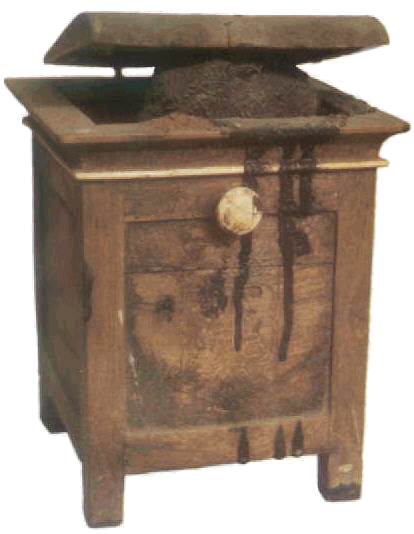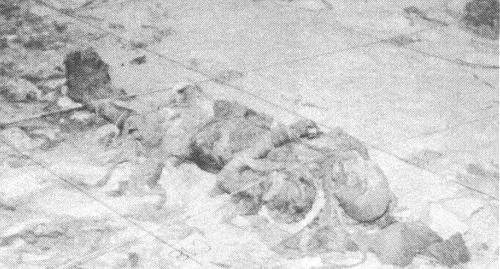|
Maat-ka-Ra Hatshepsut |
last update:
29.11.2008
|
| |
Where is the mummy?
|
|
| A wooden box with her cartouche is assigned to the burial of
Hatschepsut. The box (see photo below) was discovered in the cache at Deir
el-Bahari (DB320) and contains the remains of mummified internal organs
(see below). Beyond that Romer found remains of her wooden
sarcophagus - beside some objects of other kings - in a pit inside the tomb of Ramesses
XI (KV4). Tomb KV4 was apparently used as a workshop for "repairing and sorting"
during the "rescue work" on the royal tombs in the times of Pinudjem I (21. dynasty). |

| Wooden and ivory box from cache DB320 showing the cartouche of Hatshepsut (below the
knob and between the two dark strips, the Ra-sign is still easy to recognize);
probably
the box contains the mummified liver or stomach as well as a part of a molar;
Egyptian Museum, Cairo JdE 26250 (photo: D. Forbes, "MaatkaRe Hatshepsut", kmt
16, 3, 2005) |
| The mummy of Hatshepsut has been missing for a long time resp.
has not been identified. Thus, several female mummies had been discussed as
possibly her body. |
| Mostly all royal mummies of the kings of the 18. dynasty
had been found in the cache at Deir el-Bahari, among them Thutmosis I (the allocation is
however questionable), Thutmosis II and III. In addition, the mummy of
an unknown woman from the New Kingdom was found next to an empty coffin
intended for a woman and the wooden-ivory box shown above (with mummified intestinal
organs [perhaps liver or stomach] and the part of a molar).
Also this mummy was suspected be that of Hatshepsut.
|
| According to Maspero (Momies Royale; quoted after LAe II,
column 1048) the box shown above was re-used in the 21. Dynasty for the burial
of the queen Maat-Ka-Ra Mutemhat. Petrie stated (probably following the opinion
of Maspero) changes in the cartouche (erasure of the name of Amun) - if so the
allocation of content would be uncertain.
|
| However, after a personal inspection
N. Reeves contradicts this assumption since he did not discover hints for an
alteration of the cartouche (Reeves, N., Valley of the Kings. 1990; Chapter I
Notes, 25).
|
| However, it is remarkable that the package [with the visceral organs], that was found in the box is obviously too large for the box and as it
prevents the lid from closing properly. Therefore, it is possibly that the
package was originally accommodated in another container and does belong to this
box. Furthermore, it must be taken into account that the package indicates a
re-use of the box in later times. |
| Furthermore, in the tomb of Amenhotep II (Amenophis II,
KV35) several mummies
from the 18. dynasty were discovered, among them in a storeroom two
women not-identified yet, one called the "Elder Lady" and the
other the "Younger Lady" (both are today in the Egyptian Museum,
Cairo). It is out of question to identify the "Younger Lady"
with Hatshepsut who most likely had become older. The "Elder Lady"
who had reached an age of more than 40 years was considered for along time to
be - perhaps - queen Tiye (Teje).
|
| Donald Ryan discussed the possibility that the mummy of Hatshepsut
had already been found but was not identified to be hers (Ryan, D. P., "Who is
buried in KV60", kmt, volume 1, No. 1, 1990). Following the
hypothesis of Elizabeth Thomas (Thomas, E., The Royal Necropoleis of Thebes,
1966; cited according to Ryan, kmt 1, 1990). Ryan
has proposed that the un-known body found in KV60 might be missing mummy of Hatshepsut. |
|
The Mummy in KV60
Carter discovered
tomb KV60 in 1903, however, he closed the robbed and undecorated tomb again after a
short inspection. According to Carters report the tomb contained two damaged
female mummies, one of it lay in a decorated coffin (KV60-B), the other
one on the floor (KV60-A). Beyond that he mentioned in his report some mummified geese.
|
| 1906 Edward Ayrton opened KV60 again. Most likely in 1908 he
has moved the mummy which
was lying in the coffin together with the coffin to the Egyptian Museum at Cairo
but there are no records about the removal.
The mummy was first registered at the museum in 1916. The coffin was inscribed with the name of Sat-Ra (wr
Sdt nfrw nswt In = Great Royal Nurse, In) who had been meanwhile
identified as the nurse of Hatshepsut.
|
|
The 2nd mummy of a partially unwrapped, fat lady (with
huge pendulous breasts) of a middle age with worn
off teeth was left in the tomb lying on the floor, as well as the red-blond
hairs which lay beneath the bald head (Ryan, 1990). Subsequently, the tomb was closed again. |

Unknown mummy of a woman in KV60-A (photo: Ryan, kmt, 1990)
| The woman had been mummified with her arms
in the position that has been usual for queens during the 18. Dynasty -
with the left arm bent over the chest. After he had rediscovered and opened the forgotten tomb in
1989 Ryan put the mummy into a wood coffin. More and better photos are
available on the web page of
Donald P. Ryan.
|
|
Recently, Z. Hawass, director-general of Egypt's Supreme Council for
Antiquities (SCA), raised an alternative hypothesis in the journal kmt 17, Nr. 2, 2006. |
On the occasion to film its occupants for a TV documentary Zahi Hawass
opened KV60 again and inspected the mummy by himself. Based on this
inspection he got convinced that the mummy left in the tomb (KV60-A) is more likely
the nurse Sat-Ra than Hatshepsut herself because:
- the very obese lady died at an advance age,
- was not very thoroughly mummified,
- and had huge pendulous breasts (not unusual for a nurse),
- the position of the left arm was not a convincing evidence of
royalty to Hawass
|
So, he appointed to search for the mummy, the one brought to
the Egyptian Museum, Cairo, The mummy was finally located in the "attic" of
the Museum. In contrast to the mummy inside KV60 the mummy brought to the
Museum (KV60-B) is in his opinion more likely that of Hatshepsut. He raised the
following observations to support his opinion:
- the right arm is extended at her side, the left arm is resting
across he abdomen,
- the left hand is closed as if it was holding something,
- the lady was very thoroughly mummified and originally wrapped in
fine linen, the fingers bandaged individually,
- the toes were obviously wrapped together (but this bandages were
torn away most likely when somebody search for gold)
- the mummy had long wavy white hair, and is about 1,50 m tall,
whereas the coffin is about 2,13 m and, therefore, suggesting that it
was not intended for this person,
- the mummy still in KV60 is significantly taller and would fit
better to the coffin,
- there is a mass of linen at the bottom auf the coffin but this is
not the same quality as what is still on the mummy actually lying in the
coffin.
|
| Hawass suggest that during the 3rd Intermediate Period (i.e.
during the
21st or 22nd Dynasty) necropolis priests took the the mummy of Hatshepsut
for reasons of security (as they did with other royal mummies) from KV20 and
placed it in KV60. The robbed mummy of Hatshepsut might have been place in
the coffin of her nurse, Sat-Ra. Therefore, the mummy now placed in that
coffin in the Museum's attic may be that of Hatshepsut and the mummy put on
the floor of KV60 may be her wet nurse, Sat-Ra. |
|
On June 27 the Supreme Council of Antiquities (SCA) has published the results of
its recent investigations. |
|
Surprisingly, the mummy which had been left in KV60-A by Ayrton is now identified
as the mummy of Hatshepsut.
|
| The results of the CT-scans done on mummy KV60-A were compared
with scans on mummies which had been identified with great certainty as her next male relatives:
Thutmosis II and III. |
| The scans indicated (Hawass, kmt 18, 3, 2007) that
Thutmosis II was about 168 cm tall and died around the age of 40 years. His
teeth were in a good condition, but he suffered from an enlarged heart which may
have been the cause of his death. Thutmosis III. was about 175 cm tall and
reached an age of about 50 years. |
| Anatomical comparisons of the visceral cranium (nasal bone,
zygomatic bone, cheek bone, mandibular ramus, mandibular angle, chin, overbite,
and forehead) showed some similarities between the three mummies, the overbite
is obviously a Thutmosid family characteristic. But in addition, KV60-A showed
also some resemblance with the "Unknown man"; JE 26217, CG 61065), which was
regarded so far as the mummy of Thutmosis I. - however, the CT investigations
ruled out that this is not the cases with great certainty.
Therefore, the results of the anatomical comparisons do not allow an identification of the
mummy KV60-A. |
| Therefore, the identification done by the SCA-experts is based
on the molar which was found during the recent CT-scans inside
the wooden box which was discovered in the cachette DB320 [and which was labeled
with the cartouche of Hatshepsut]. The molar is missing one of its roots.
According to CT-investigations the molar fits very well into a gap in the right upper
jaw of the mummy KV60-A where also the missing root is present.
|
|
The "Identification" by the SCA is thus based only on pictures from CT-Scans,
one shows a molar which is missing one of its roots, the other shows a gap in
the right lower jaw of the lady KV-60A in which the molar may fit, and the
assumption that the molar, since it has been discovered in a box with the name
of the queen, is really hers. |
| The lady KV60-A now identified as Hatshepsut was about 159 cm tall and died
between the ages of 46 to 60. At the end of her life she was so obese that - so
Hawass - the
visceral organs had to be removed through the pelvic floor than through the
usual abdominal incision. Her brain was left inside. |
| According to the CT scans she suffered from osteoporosis,
arthritis of the spinal column, and had a slipped disk. A soft tissue mass,
which arose from the left iliac bone (Os ilium) and was eroding both of its
surfaces, indicated metastasized cancer [no primary tumor was found]. A decrease
in the density of the bones of the spine gives further evidence in the same
direction. |
| The teeth were in an extremely bad condition. The density of
the teeth was reduced, numerous had caries and/or were broken off. The 7th upper
molar on the right side had broken off, the root was however still embedded in
the jaw. Together with the obesity the bad condition of the teeth points to a
diabetes mellitus. |
|
The SCA has decided to do additional investigation on DNA samples since the
mummies of some relatives are at hand - although not all identified with
certainty. |
|
First results on mitochondrial DNA samples taken from the mummy's pelvic bone and femur
have been compared to the mummy of Hatshepsut's grandmother Ahmes-Nefertari showed some relationships.
However, the investigations have not been finished yet. |
|

